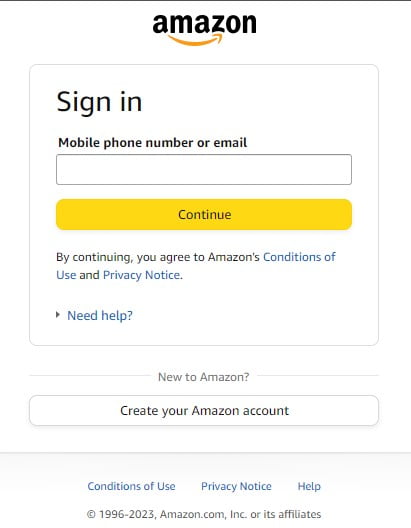As online marketplaces continue to flourish, Amazon stands as a pioneer in the world of e-commerce. Amidst the retail opportunities, a persistent question lingers: Can you have multiple Amazon accounts connected?
This blog post dives deep into the intricacies of this commonly asked question to provide clarity on the feasibility and step-by-step process involved in effectively managing multiple Amazon accounts.





 An all-in-one e-commerce management solution that integrates sales channels, tracks inventory, automates updates, and streamlines shipping. Pricing starts from $49/month.
An all-in-one e-commerce management solution that integrates sales channels, tracks inventory, automates updates, and streamlines shipping. Pricing starts from $49/month.
 A revolutionary multi-channel analytics reporting tool offering the ability to link multiple Amazon seller accounts.
Streamline your Amazon account management effortlessly with these powerful apps that simplify operations and enhance efficiency across your e-commerce endeavors.
A revolutionary multi-channel analytics reporting tool offering the ability to link multiple Amazon seller accounts.
Streamline your Amazon account management effortlessly with these powerful apps that simplify operations and enhance efficiency across your e-commerce endeavors.


Are Users Allowed to Have Multiple Seller Accounts?
The quick answer is yes, users can have multiple seller accounts on Amazon under certain conditions. Amazon permits Selling Partners to operate multiple accounts if there is a legitimate business need. For instance:- owning distinct brands
- managing separate businesses
- manufacturing products for separate companies
- or participating in specific Amazon programs that require separate accounts.

Advantages of Having Multiple Amazon Accounts
Multiple Amazon accounts can offer some advantages in specific situations, but Amazon’s policies and terms of use may change over time. Here are some potential advantages of having multiple Amazon accounts:1. Increase Sales and Revenue
If your business is already experiencing significant growth, strategically opening multiple Amazon accounts can be highly advantageous. This approach amplifies your product visibility and enhances the potential for increased monthly revenue across distinct accounts.2. Diversify Business
If you aim to enhance your business’s diversity, employing multiple Amazon accounts can effectively amalgamate various products or services, leading to a notable boost in sales.3. Expand Your Business
Utilizing multiple seller accounts enables business expansion into new markets, ensuring compliance with local regulations and accessing untapped customer bases.4. Establish Your Brand
Creating distinct accounts for various product lines allows a seller to enhance expertise and credibility. For instance, maintaining separate home decor and footwear accounts enables tailored branding, attracting specific customers and solidifying an expert reputation.5. Reduce Business Risk
Having multiple seller accounts mitigates business risk. If one account is deactivated or suspended, other accounts can continue selling, acting as backups and ensuring business continuity. While this may have some drawbacks, it aids in establishing and expanding your business.6. Run Different Business Models
You must establish a distinct Amazon seller account to transition your business model from B2C to B2B. This prevents conflicts with your current business and enables a seamless model shift. Managing multiple accounts empowers you to pursue diverse models and cater to distinct customer segments, broadening your business prospects.
Disadvantages of Having Multiple Amazon Accounts
Navigating the complexities of managing multiple Amazon accounts can offer certain advantages, but you must also understand the potential drawbacks.
1. Increased Management Effort for Multiple Accounts
Managing a single Amazon account demands significant time and effort. For better outcomes, handling multiple accounts necessitates doubling your time and commitment.2. Potential Rise in Unfavorable Feedback
Inadequate customer service or delayed shipping can lead to heightened negative feedback, potentially causing reduced sales and revenue loss.3. Heightened Possibility of Account Closure
Not following Amazon’s seller guidelines may lead to seller account suspension, which could significantly impact you, especially if you’re currently experiencing substantial profits.4. Proneness to Human Errors with Multiple Accounts
Juggling multiple seller accounts increases the chance of human errors like listing incorrect products or mixing up orders. This confuses customers and may result in negative feedback.Should you Create Multiple Seller Accounts?
There are specific scenarios where establishing multiple Amazon seller accounts might be advantageous. These situations include:1. Expanding Internationally
When aiming to tap into various Amazon marketplaces across different countries – such as the US, Australia, or the Netherlands – distinct seller accounts are necessary. Each marketplace operates under its own rules, regulations, and prerequisites.2. Brand Management
Maintaining separate seller accounts for each brand can aid the organization if you oversee multiple brands. This separation facilitates individual management of sales, advertising metrics, and seller feedback.3. Diverse Product Categories
Amazon enforces specific standards for selling within distinct product categories. If you intend to offer products across multiple categories, creating separate seller accounts for each category ensures adherence to Amazon’s policies. When contemplating the creation of multiple seller accounts, carefully assess your unique circumstances against these considerations to determine the most appropriate strategy for your Amazon selling endeavors.How to Open Multiple Amazon Seller Accounts?
If you’re considering setting up multiple Amazon seller accounts, it’s crucial to understand when appropriate and be aware of the pros and cons. Here’s the process:
1. Access the Amazon Website
Start by visiting the Amazon website using any web browser. Click on “Accounts and Lists“, located in the top right corner, to reach the login page.
2. Create a New Account
On the login page, select “Create your Amazon Account.” Fill in the required fields, your name, email address, password, and other necessary details.3. Complete Registration
Once you’ve entered the required information, choose “Create Your Amazon Account” from the menu. This step finalizes your registration. Remember that maintaining multiple seller accounts comes with challenges and benefits, so weigh your options carefully.Considerations for Setting Up Your Second Amazon Seller Account
When creating an additional Amazon seller account, there must not be any similarities in:- phone number
- Entity
- Address
- Bank
- credit card
- Brand
- Listings
- and so on.
The Challenges of Multiple Amazon Seller Accounts
Managing multiple Amazon seller accounts can be nerve-wracking, as mistakes could lead to account closures, including your original one. Staying within the rules is crucial to avoid being flagged or detected for unauthorized accounts. Challenges include time-consuming manual updates for listings, lack of synchronization in managing accounts, inventory, and orders, susceptibility to user errors, and the substantial time and effort needed for effective account management.Top Apps for Efficiently Handling Multiple Amazon Accounts
Explore these effective apps to seamlessly handle multiple Amazon accounts and tackle the challenges: An all-in-one e-commerce management solution that integrates sales channels, tracks inventory, automates updates, and streamlines shipping. Pricing starts from $49/month.
An all-in-one e-commerce management solution that integrates sales channels, tracks inventory, automates updates, and streamlines shipping. Pricing starts from $49/month.
 A revolutionary multi-channel analytics reporting tool offering the ability to link multiple Amazon seller accounts.
Streamline your Amazon account management effortlessly with these powerful apps that simplify operations and enhance efficiency across your e-commerce endeavors.
A revolutionary multi-channel analytics reporting tool offering the ability to link multiple Amazon seller accounts.
Streamline your Amazon account management effortlessly with these powerful apps that simplify operations and enhance efficiency across your e-commerce endeavors.

Maximize Your Amazon Seller Potential – Discover SellerAppeal’s Expert Solutions Today
While having multiple accounts may offer advantages, such as separating personal and business transactions or targeting different markets, it’s crucial to tread carefully and adhere to Amazon’s guidelines. Maintaining transparency, avoiding duplicate or prohibited activities, and managing your accounts ethically should be your top priorities. If you’re considering expanding your presence on Amazon or have questions about managing multiple seller accounts, SellerAppeal is here to help. Contact us today to explore tailored solutions and strategies that align with your goals, ensuring you make the most of your Amazon selling journey.FAQs About Having Multiple Amazon Seller Accounts
Get your questions about multiple seller accounts answered.1. Is maintaining numerous Amazon accounts against the law?
Having multiple Amazon seller accounts isn’t illegal, but it must align with Amazon’s guidelines. Sellers can have multiple accounts for a valid business reason, like selling in distinct categories or separating personal and business transactions. Permission and proper documentation are essential.2. What are effective methods for handling multiple Amazon seller accounts efficiently?
Effectively managing multiple Amazon seller accounts hinges on adhering to specific guidelines. Begin by securing approval from Amazon Seller Performance to sidestep potential account blocks. Once sanctioned, proceed cautiously. Refrain from IP address switches, as Amazon may deem this illicit. Keep distinct bank accounts and financial IDs for each account to evade confusion.3. What steps can be taken to obtain authorization for handling multiple Amazon seller accounts?
To secure approval, adhere to Amazon’s policies, ensuring each account has distinct email, bank, and credit card details. Follow these steps:- Confirm Eligibility: Verify eligibility based on legitimate business needs, as Amazon often permits multiple accounts for valid reasons.
- Application Submission: Access Amazon Seller Central, click “Register now,” and accurately complete the application with essential personal or business information.
- Supporting Documentation: Provide necessary documents like business licenses or tax IDs depending on the account type.
- Await Approval: Amazon reviews applications, typically within a few days. Monitor emails and your seller dashboard for updates.
4. What is the maximum number of Amazon seller accounts a seller can possess?
Generally, Amazon permits one seller account per individual, with exceptions for valid business reasons. However, in specific cases, like separate businesses or international operations, multiple accounts might be allowed.5. How does Amazon identify the presence of multiple accounts?
Amazon employs various methods, including:- Device ID: Amazon notes device identifiers, flagging logins from the same device for multiple accounts, which can lead to suspension.
- IP Address: Repeated logins from a single IP address across accounts can signal policy violations.
- Credit Card: Using one credit card for multiple accounts can breach Amazon’s policies.
- Bank Account: Similar bank accounts across accounts can violate Amazon’s policies.
- Company Name: Reusing a company name for multiple accounts can breach policies.
- Billing/Shipping Address: Sharing addresses among accounts can breach Amazon’s policies.
- Phone Number: Employing the same phone number for multiple accounts can breach policies.
Contact Us
Looking for effective Amazon seller account reinstatement solutions? You’re in the right place! We’ve helped dozens upon dozens of sellers get their accounts back in excellent standing in record time.
Feel free to contact us today to learn more about our services and how you can benefit.

